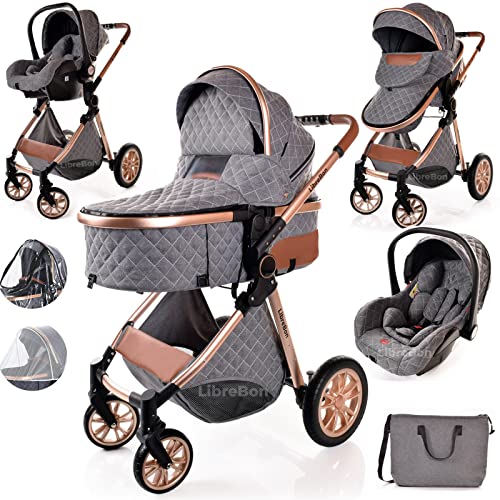15 Funny People Working Secretly In Prams
Prams and Pushchairs: A Comprehensive Guide for New Parents
Navigating the world of baby transportation can be overwhelming for new moms and dads, particularly when it pertains to selecting in between prams and pushchairs. Each option offers unique benefits and constraints, suggesting that making an informed decision is vital. This post aims to provide a thorough understanding of prams and pushchairs, their differences, features to consider, and suggestions for picking the ideal one.
Understanding the Basics: Prams vs. Pushchairs
Prams and pushchairs are terms frequently used interchangeably, however they describe various kinds of baby transport systems.
Definitions:
- Prams: Traditionally developed for newborns and babies, prams have a big, totally flat bassinet that enables ideal comfort and security during early phases of a child's life.
- Pushchairs: Designed for older babies and toddlers, pushchairs typically have an upright seat that appropriates for children who can support their head and neck. They typically come with adjustable recline alternatives.
Key Differences
Function
Pram
Pushchair
Style
Flat bassinet
Upright seat
Age Suitability
Newborn to around 6 months
6 months to 4 years
Mobility
Generally heavier, less foldable
Often light-weight and foldable
Comfort
Relaxing for newborns, snug fit
Adjustable, can be reclined
Use
Ideal for strolls and leisure
Versatile for everyday activities and travel
Functions to Consider When Choosing Prams and Pushchairs
Safety Features
- Harness systems (5-point vs. 3-point)
- Braking systems (foot-operated vs. hand-operated)
- Stability and sturdiness of the frame
Weight and Portability
- Consider the weight of the pram or pushchair
- Search for a design that folds quickly for transport
Size and Storage
- Check measurements for fitting through entrances and in automobile trunks
- Try to find extra storage options like baskets or pockets
Convenience
- Padded seats and adjustable recline positions
- Suspension systems for smoother trips on rough terrains
Weather Protection
- UV security in sunshades
- Choices for rain covers and windscreens
Wheels and Maneuverability
- Wheel size and type (fixed vs. swivel)
- Suspension systems that help handling and comfort
Longevity
- Designs that transform from pram to pushchair
- Tougher frames that can accommodate growing kids
Popular Types of Prams and Pushchairs
When thinking about prams and pushchairs, moms and dads often find numerous styles dealing with particular needs. Here are some popular types:
1. Standard Prams/Pushchairs
These are great all-rounders, created for everyday use with a tough frame and ample storage space. They are typically adjustable and can handle numerous surfaces.
2. Travel Systems
These include a safety seat and a stroller that can be utilized together, making it easy to transfer the baby from the car to the pram without waking them up.
3. Umbrella Strollers
These are light-weight and foldable, perfect for fast trips and travel. While hassle-free, they typically do not have a few of the security and convenience features found in heavier designs.
4. All-Terrain Strollers
Created for off-road experiences, these strollers have bigger wheels and a more rugged frame, making them perfect for active families.
Choosing the Right Pram or Pushchair
When selecting the best pram or pushchair, moms and dads ought to take the following steps:
Assess Lifestyle Needs: Consider how you will use the pram or pushchair (day-to-day walks, travel, unequal terrain) and select appropriately.
Test Drive: It's helpful to physically evaluate the models at the shop, inspecting for dealing with, comfort, and weight.
Research study Brands: Look at evaluations and suggestions from other moms and dads about specific brand names or models.
Consider Future Needs: Think ahead to guarantee the choice will work as the child grows. Convertible models provide flexibility.
Spending plan: Set a budget plan but likewise consider quality and longevity. In some cases investing more initially can conserve costs in the long run.
Regularly Asked Questions
What is the very best age to start utilizing a pushchair?
Many pushchairs can be utilized for babies from about 6 months old when they can adequately support their heads and necks. Make certain to inspect the producer's requirements.
Are prams ideal for newborns?
Yes, prams are ideally matched for newborns due to their flat bassinet design, offering a comfy and protected environment.
How do I clean a pram or pushchair?
Constantly describe the maker's standards, but a lot of covers are removable and can be washed. Wipe down the frame with a wet cloth and avoid utilizing severe chemicals.
Can I use a pram or pushchair on public transportation?
Various models vary in size; light-weight and foldable alternatives are usually better for buses or trains. Nevertheless, constantly check for transportation guidelines in your area.
How long can I use a pram or pushchair?
It usually depends upon the weight limit specified by the maker, typically between 15-50 pounds, or till your child no longer wishes to be pushed.
Picking in between a pram and a pushchair is a considerable choice that accommodates the lifestyle and needs of both the moms and dad and the kid. By understanding the distinctions between the two, examining important functions, and choosing the right model, moms and dads can guarantee they have a safe, comfy, and useful transportation option for their children.
Equipping oneself with knowledge supplies parents not just comfort but also the confidence to make the very best option for their child's early adventure into the world. Various lifestyles demand different services, so taking the time to research and test what fits can reduce a few of the tensions that include new parenthood. Prams Pushchairs UK strolling!
